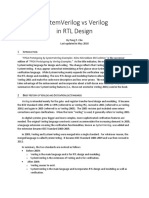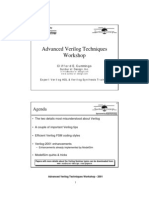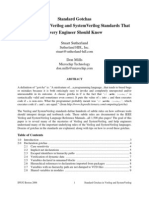Ece5950 Tut4 Vcs GL
Ece5950 Tut4 Vcs GL
Uploaded by
Vijay Kumar NCopyright:
Available Formats
Ece5950 Tut4 Vcs GL
Ece5950 Tut4 Vcs GL
Uploaded by
Vijay Kumar NOriginal Title
Copyright
Available Formats
Share this document
Did you find this document useful?
Is this content inappropriate?
Copyright:
Available Formats
Ece5950 Tut4 Vcs GL
Ece5950 Tut4 Vcs GL
Uploaded by
Vijay Kumar NCopyright:
Available Formats
Gate-Level Simulation using Synopsys VCS
ECE5950 Tutorial 4 (Version 28703ca) February 3, 2012 Derek Lockhart
Contents
1 2 3 4 5 6 Introduction . . . . . . . . . . . . . . . . . Getting The Tutorial Code . . . . . . . . Manual VCS Build Process . . . . . . . . Automated VCS Build Process . . . . . . Viewing Trace Output With GTKWave Acknowledgements . . . . . . . . . . . . . . . . . . . . . . . . . . . . . . . . . . . . . . . . . . . . . . . . . . . . . . . . . . . . . . . . . . . . . . . . . . . . . . . . . . . . . . . . . . . . . . . . . . . . . . . . . . . . . . . . . . . . . . . . . . . . . . . . . . . . . . . . . . . . . . . . . . . . . . . 1 1 3 4 5 5
Introduction
In this tutorial you will gain experience compiling Gate-Level Netlists generated by Synopsys Design Compiler and IC Compiler into cycle-accurate executable simulators using Synopsys VCS. Figure 1 illustrates the basic gate-level simulation toolow and how it ts into the larger ECE5950 ow. Performing gate-level simulation gives us the opportunity to check that our circuit still works properly after being Synthesized and Placed and Routed. Additionally, we use the gate-level simulations to obtain switching activies for each gate in the design. This will allow us to estimate power and energy. For this tutorial we will be performing gate-level simulation on the netlist of the synthesized, placed, and routed greatest common divisor (GCD) circuit, which you should have generated in Tutorial 3. While we will be focusing on Post-Place-and-Route gate-level simulation in this tutorial, the same principles apply to Post-Synthesis gate-level simulation. Typically we are only ever interested in Post-Synthesis gate-level simulation for debugging purposes. Note that this tutorial is by no means comprehensive. Should you nd yourself wanting to refer to more authoritative sources on VCS, GTKWave, and Verilog, you can nd the following relevant documents on the BRG servers at /ufs/brg/courses/ece5950/docs: vcs.pdf - VCS User Guide ucli ug.pdf - Unied Command Line Interface User Guide gtkwave.pdf - GTKWave Documentation
Getting The Tutorial Code
All of the ECE5950 tutorials should be run on the BRG compute servers brg-01.csl.cornell.edu and brg-02.csl.cornell.edu. Before proceeding further, please log into one of these machines. You should follow along through the tutorial yourself by typing in the commands marked with a % symbol at the shell prompt. To cut and paste commands from this tutorial into your bash shell (and make sure bash ignores the % character) use an alias to undene the % character: % alias %="" Once you have logged into a BRG machine you will need to setup the ECE5950 toolow with the following commands:
(Version 28703ca), Spring 2012
Verilog Source (.v)
Verilog Testbench (.v)
Standard Cell Models (.v)
Constraints (.tcl)
Standard Cell Library (see below)
TLU+ Files (.tluplus)
iverilog
VCS
Design Compiler
IC Compiler
RTL Simulator (a.out)
RTL Simulator (simv)
Delay File (.sdf)
Timing & Area
Gate Level Netlist (.v)
Constraints File (.sdc)
Floor Plan
./a.out
./simv
VCS
Design Vision GUI
IC Compiler
Test Results (.out)
Waveform (.vpd or .vcd)
RTL Simulator (simv)
Delay File (.sdf)
Gate Level Netlist (.v)
Parasitics (sbpf.min, sbpf.max)
Constraints File (.sdc)
Timing & Area
Layout
GTKWave
./simv
VCS
IC Compiler GUI
Test Results (.out)
Waveform (.vcd)
Post-P&R Simulator (simv) Standard Cell Library:
GTKWave
./simv
Technology Library (.db) Milkyway Reference DB (.fr) Technology File (.tf) Mapping File (.map) Waveform (.vcd)
RTL Simulation Synthesis Place & Route Gate-Level Simulation Power Estimation (Optional Flow Elements)
Test Results (.out)
GTKWave
VCD2SAIF
Activity File (.saif)
PrimeTime
Power Estimates
Figure 1: VCS Toolow
(Version 28703ca), Spring 2012
% source setup-brg.sh % source setup-ece5950.sh For this tutorial you will be using a GCD circuit as your example design. If you dont already have the source les from the previous tutorials, create a work directory and clone the tutorial les from the git repository: % % % % % mkdir -p /tmp/$USER/vc cd /tmp/$USER/vc git clone /ufs/brg/courses/ece5950/ece5950-tutorial cd ece5950-tutorial/tutorial TUTROOT=$PWD
Before starting, take a look at the subdirectories in the project directory. Note that there are directories for your RTL source (src) and for generated content (build). The build directory has subdirectories for each major step in the ECE5950 toolow, these subdirectories contain scripts and conguration les necessary for running the tools. For this tutorial you will work exclusively in the vcs-sim-gl-par subdirectory.
Manual VCS Build Process
We will rst manually go through the steps for performing gate-level simulation with VCS using the commandline. Since this process is tedious we will only do it once, later we will use scripts to automate the steps in this portion of the ow for us. For now, you should be able to cut and paste the commands below into your terminal: % cd $TUTROOT/build/vcs-sim-gl-par % vcs -full64 -notice +lint=all,noVCDE,noTFIPC,noIWU,noOUDPE +v2k -timescale=1ns/1ps \ -P ../icc-par/current-icc/access.tab -debug +neg_tchk \ +define+CLOCK_PERIOD=0.5 +incdir+../../../vclib/src \ -v ../../../vclib/src/vcQueues.v \ -v ../../../vclib/src/vcStateElements.v \ -v ../../../vclib/src/vcTest.v \ -v ../../../vclib/src/vcTestSource.v \ -v ../../../vclib/src/vcTestSink.v \ ../../src/gcdTestHarness_rtl.v \ ../icc-par/current-icc/results/gcdGCDUnit_rtl.output.v \ /ufs/brg/home/lockhart/vc/git-brg/personal-lockhart/saed90nm-simplecells/cells_simple.v The parameters passed to VCS to generate the gate-level simulator are a bit dierent than those used to compile the RTL simulator. A few additional runtime ags are used (these ags are discussed in a bit more detail below), but more importantly, the Verilog les provided for compilation are quite dierent. Although the test harness and vc library les used by the harness remain the same, we replace the Verilog RTL les with the gate-level netlist generated by IC Compiler (gcdGCDUnit rtl.output.v) and a cell model le that describes the behavior of each gate (cells simple.v). If you look at the gate-level netlist, you should see that it is an entirely structural description that merely wires together instances of the gates dened in the cell model le. Typically the cell model le is provided by the same vendor as your standard cells and has additional functionality beyond just basic behavioral gate descriptions. This additional functionality includes realistic (non-ideal) transition dependent delays for state elements, as well as hooks for annotating each gate in the design with IC Compiler generated delay information (the .sdf le). Unfortunately, these additional facilities, which are meant to more accurately model real chip behavior, can make it extremely dicult to get gate-level simulation to work properly. For the sake of simplicity, we are using our own standard cell behavioral models that do not include this extra timing information. Our simple cells are enough to accurately model the circuit for behavioral and
(Version 28703ca), Spring 2012
power analysis purposes, although it will not include glitching eects and the power consumption due to those eects. When fabricating an actual chip, you will denitely want to use the vendor provided cells and ensure all tests pass without any setup or hold time violations. Important runtime ags: -notice enables verbose diagnostic messages. +lint=all,noVCDE,noTFIPC,noIWU,noOUDPE turns on Verilog warnings except the following warnings: VCDE - Verilog compiler directive encountered. TFIPC - Too few instance port connections. IWU - Implicit wire used. OUDPE - UDP entries overlap. -P <file.tab> load a PLI table le. The the access.tab table le is used to give write access to certain registers in our design so that we can we can initialize them to a known value during simulation. For more info, see below. After running the VCS command from above, you should see text output indicating that VCS is parsing the Verilog les and compiling the modules. Once compilation has completed, go ahead an execute the simulator: % ./simv -ucli -do run.tcl +verbose=1 Running the simv executable with the verbose ag should show you that the simulation executes and successfully passes all tests. You should notice that there are a few extra parameters passed to the gate-level simulator compared to the RTL simulator discussed in Tutorial 1. The -ucli -do run.tcl parameters tell the Synopsys Unied Command Line Interface to execute the run.tcl script at the beginning of the VCS simulation. If you look at this script, youll see that it sources and executes the force regs.ucli script generated by IC Compiler. According to Synopsys documentation, unitialized register values can result in x pessimism, and this same x pessimism can cause gate-level simulation to fail even if your design is correct. The purpose of the force regs.ucli script (and also the access.tab le passed to VCS during compilation) is to avoid this problem by initializing all state elements to a known value at simulation time. Typically reset signals are used to set critical state (usually control logic) to known values at startup, but non-critical state (usually datapath registers) will often omit reset signals in order to save area.
Automated VCS Build Process
Typing each command via the commandline is a tedious and error-prone process, and should typically be avoided. Instead, we make use of scripts to automate the process of building our tools for us. The following commands will rst delete the simulator you previously built, and then regenerate it using the makele. % cd $TUTROOT/build/vcs-sim-gl-par % make check % make run Some of the labs will include a build directory for Post-Synthesis gate-level simulation called vcs-sim-gl-syn in addition to the Post-Place-and-Route simulator vcs-sim-gl-par. Because the Post-Synthesis gate-level models arent as accurate as the Post-Place-and-Route ones, they will not be used for obtaining power estimates. However, should your Post-Place-and-Route gate-level simulations fail, it may be useful to use the Post-Synthesis simulation to aid in debugging and help determine if the errors are being introduced in synthesis or in place and route.
(Version 28703ca), Spring 2012
To try running the Post-Synthesis simulator, you can execute the following commands in your Lab 1 build directory: % cd $LABROOT/build/vcs-sim-gl-syn % make check % make run
Viewing Trace Output With GTKWave
You can view the results of the gate-level simulation by opening the generated vcd le in GTKWave, similar to what was described in Tutorial 1. You may notice that some of the signals in your design do not behave as expected, and additional signals which you did not use in your design are present. This is due to optimizations done during synthesis, place, and route which will get rid of signals and add new ones in order to improve performance or reduce area. For more information on using GTKWave, see Tutorial 1: RTL Simulation using Synopsys VCS.
Acknowledgements
Many sources have contributed to the content of this tutorial. The original material for this tutorial was developed as a lab for the CS250 VLSI Systems Design course at University of California at Berkeley by Yunsup Lee. Contributors include: Krste Asanovi, Christopher Batten, John Lazzaro, and John Wawrzynek. c Versions of that lab have been used in the following courses: CS250 VLSI Systems Design (2009-2011) - University of California at Berkeley CSE291 Manycore System Design (2009) - University of California at San Diego
You might also like
- Phy Interface Pci Express Sata Usb31 Architectures PIPE - Rev6 - 2 - 1Document187 pagesPhy Interface Pci Express Sata Usb31 Architectures PIPE - Rev6 - 2 - 1sitaradingNo ratings yet
- UVM Harness WhitepaperDocument12 pagesUVM Harness WhitepaperSujith Paul VargheseNo ratings yet
- UVM Registers On DemandDocument8 pagesUVM Registers On DemandSandeep VenkateshNo ratings yet
- Using Parameterised ClassesDocument14 pagesUsing Parameterised ClassespriyajeejoNo ratings yet
- If Systemverilog Is So Good, Why Do We Need The Uvm?: Sharing Responsibilities Between Libraries and The Core LanguageDocument7 pagesIf Systemverilog Is So Good, Why Do We Need The Uvm?: Sharing Responsibilities Between Libraries and The Core LanguageSupalShahNo ratings yet
- 2013 SNUG SV Synthesizable SystemVerilog PaperDocument45 pages2013 SNUG SV Synthesizable SystemVerilog PaperNvskinIdNo ratings yet
- PrecisionRTL StyleDocument345 pagesPrecisionRTL Stylenegrea_c8079No ratings yet
- SystemVerilog Vs Verilog in RTL DesignDocument4 pagesSystemVerilog Vs Verilog in RTL DesignVijay KumarNo ratings yet
- Business Events in Oracle Applications - A Sample ImplementationDocument6 pagesBusiness Events in Oracle Applications - A Sample ImplementationAshish HarbhajankaNo ratings yet
- Windows Server 2019 Product PresentationDocument12 pagesWindows Server 2019 Product PresentationMirza CerimNo ratings yet
- Ece5745 Tut5 PT PDFDocument5 pagesEce5745 Tut5 PT PDFStudentNo ratings yet
- Key Concerns For Verifying Socs: Figure 1: Important Areas During Soc VerificationDocument5 pagesKey Concerns For Verifying Socs: Figure 1: Important Areas During Soc Verificationsiddu. sidduNo ratings yet
- Reuse of SV-UVM Based IP Verification Environment at SoC - Challenges InvolvedDocument15 pagesReuse of SV-UVM Based IP Verification Environment at SoC - Challenges InvolvedKrishna Unv100% (1)
- Advanced Verilog CodingDocument76 pagesAdvanced Verilog Coding1234GAURAVNo ratings yet
- Verification Approach For ASIC Generic IP Functional VerificationDocument3 pagesVerification Approach For ASIC Generic IP Functional VerificationMohammad Seemab AslamNo ratings yet
- What Is Assertion-Based Verification?: Active PassiveDocument4 pagesWhat Is Assertion-Based Verification?: Active PassiveAli HmedatNo ratings yet
- Verification of AHB Protocol For AHB-Wishbone Bridge Using SystemVerilogDocument4 pagesVerification of AHB Protocol For AHB-Wishbone Bridge Using SystemVerilogEditor IJRITCCNo ratings yet
- CummingsSNUG2014AUS UVM MessagesDocument33 pagesCummingsSNUG2014AUS UVM MessagesKalpana ChaudharyNo ratings yet
- Verilog Gotchas Part1Document63 pagesVerilog Gotchas Part1Anish JosephNo ratings yet
- UVM Tutorial For Candy Lovers - 2Document9 pagesUVM Tutorial For Candy Lovers - 2nvenkatesh485No ratings yet
- I 2 CDocument16 pagesI 2 CelumalaianithaNo ratings yet
- Equivalence CheckingDocument22 pagesEquivalence CheckingINGALE PRATAP ASHOKNo ratings yet
- Vlsi Design of Amba Based Ahb2apb BridgeDocument12 pagesVlsi Design of Amba Based Ahb2apb BridgeAnonymous e4UpOQEPNo ratings yet
- UVM Register Back Door AccessDocument7 pagesUVM Register Back Door AccessSandeep VenkateshNo ratings yet
- Comparing AHB To AXI BusDocument12 pagesComparing AHB To AXI BussckidNo ratings yet
- Et FlowsDocument196 pagesEt FlowsNitish KumarNo ratings yet
- CummingsSNUG2008Boston CDCDocument56 pagesCummingsSNUG2008Boston CDCKiran RaoNo ratings yet
- CummingsSNUG2016SV SVLogicProcsDocument32 pagesCummingsSNUG2016SV SVLogicProcsspaulsNo ratings yet
- Cummingssnug2009sj Sva BindDocument42 pagesCummingssnug2009sj Sva BindSuresh KumarNo ratings yet
- Cummings Why Use Classes For UVM TransactionsDocument2 pagesCummings Why Use Classes For UVM Transactionsvishwalatha sNo ratings yet
- Lab 6 Introduction To VerilogDocument7 pagesLab 6 Introduction To Verilogmmorsy1981No ratings yet
- Cadence TLM WPDocument9 pagesCadence TLM WPcoolpartha25No ratings yet
- Verilog 2012Document70 pagesVerilog 2012Bach TrungNo ratings yet
- Chap 1 VerilogDocument7 pagesChap 1 VeriloglordfiendNo ratings yet
- 2005-SNUG-Paper SystemVerilog Unique and PriorityDocument24 pages2005-SNUG-Paper SystemVerilog Unique and Priorityvaibhav27aprilNo ratings yet
- SystemVerilog 3.0d.VCS7.1 Beta PDFDocument314 pagesSystemVerilog 3.0d.VCS7.1 Beta PDFlaurent_pubsNo ratings yet
- VCS 4.1 GuideDocument34 pagesVCS 4.1 GuideamitchahalNo ratings yet
- Design Flow VlsiDocument42 pagesDesign Flow VlsiRahul ShandilyaNo ratings yet
- Advanced Verifivstion Topics IndexDocument6 pagesAdvanced Verifivstion Topics IndexNavnish GargNo ratings yet
- Cadence Analog and Mixed Signal Design: Features/BenefitsDocument2 pagesCadence Analog and Mixed Signal Design: Features/Benefitsvishwanath HiremathNo ratings yet
- Spy Glass Quick GuideDocument18 pagesSpy Glass Quick Guidecurliph0% (1)
- Design of VLSI Architecture For A Flexible Testbed of Artificial Neural Network For Training and Testing On FPGADocument7 pagesDesign of VLSI Architecture For A Flexible Testbed of Artificial Neural Network For Training and Testing On FPGAInternational Journal of Innovative Science and Research TechnologyNo ratings yet
- Verilog Tutorial For BeginnersDocument4 pagesVerilog Tutorial For BeginnersNovelyn RabinoNo ratings yet
- Functional Coverage Development Tips Dos and Donts VH v10 I2Document6 pagesFunctional Coverage Development Tips Dos and Donts VH v10 I2himabindu2305No ratings yet
- Dvcon2017 Uvm Debug Lib FinalDocument9 pagesDvcon2017 Uvm Debug Lib FinalIkshvaku ModiNo ratings yet
- VCMDocument522 pagesVCMSai Kumar NallagangulaNo ratings yet
- Hierarchical Testbench Configuration Using UvmDocument12 pagesHierarchical Testbench Configuration Using UvmamigottpNo ratings yet
- SNUG10 Fork PaperDocument30 pagesSNUG10 Fork Papersurekha-smitha-1505No ratings yet
- AMBA Transactors User and Reference Guide: Product Version 5.4 May 2005Document170 pagesAMBA Transactors User and Reference Guide: Product Version 5.4 May 2005Pardhasaradhi DamarlaNo ratings yet
- ModelSim ME v10.5c User PDFDocument808 pagesModelSim ME v10.5c User PDFBasil FawltyNo ratings yet
- 2012 DVCon SystemVerilog 2012 PaperDocument13 pages2012 DVCon SystemVerilog 2012 Papercoolkad81No ratings yet
- Advanced UVM: Modeling TransactionsDocument26 pagesAdvanced UVM: Modeling TransactionsmanchuricoNo ratings yet
- Cummings Snug 2006 Boston SystemVerilog EventsDocument42 pagesCummings Snug 2006 Boston SystemVerilog Eventsm2yeeNo ratings yet
- Verilog Creating Analog Behavioral ModelsDocument24 pagesVerilog Creating Analog Behavioral ModelsMarco PriviteraNo ratings yet
- Advanced Verification PDFDocument34 pagesAdvanced Verification PDFjit20088791No ratings yet
- Verification TutorialDocument14 pagesVerification TutorialAdemar Gregoruti JuniorNo ratings yet
- Ece5745 Tut1 VcsDocument7 pagesEce5745 Tut1 VcsKiran KumarNo ratings yet
- Lab1 GCDDocument26 pagesLab1 GCDPrasad KalumuNo ratings yet
- Design Compiler SynthesisDocument14 pagesDesign Compiler SynthesisafriendNo ratings yet
- Ece5950 Tut2 DC PDFDocument15 pagesEce5950 Tut2 DC PDFsudip_on_air1No ratings yet
- Fancyhdr PDFDocument2 pagesFancyhdr PDFKellzNo ratings yet
- AWS Certified Advanced Networking - Specialty (ANS-C00) Sample Exam QuestionsDocument5 pagesAWS Certified Advanced Networking - Specialty (ANS-C00) Sample Exam QuestionsRamNo ratings yet
- DSL: An Overview: by M. V. Ramana MurthyDocument9 pagesDSL: An Overview: by M. V. Ramana Murthyvijay_786No ratings yet
- PC Tool User Instructions Manual PDFDocument11 pagesPC Tool User Instructions Manual PDFJonellNo ratings yet
- Winbond W55Fxx: Data SheetDocument12 pagesWinbond W55Fxx: Data SheetCalin LuchianNo ratings yet
- Signalling Dimensioning: GSM-GPRS OperationDocument50 pagesSignalling Dimensioning: GSM-GPRS OperationVulpe FlorianNo ratings yet
- JDD - Empowerment 12 - Midterm Handout - 20-21Document5 pagesJDD - Empowerment 12 - Midterm Handout - 20-21Brian Omaña Deconlay EmhayNo ratings yet
- Communication Module 80 105: + - + - + - + - + - + - + - + - + - + - EL+ 1 7 14 2 8 15 20 9 16 21 Kanal ChannelDocument4 pagesCommunication Module 80 105: + - + - + - + - + - + - + - + - + - + - EL+ 1 7 14 2 8 15 20 9 16 21 Kanal ChannelGilberto Alejandro Tun BritoNo ratings yet
- Fpga Tools HowtoDocument27 pagesFpga Tools Howtomdzakir_hussainNo ratings yet
- Cisco Packet Tracer 53Document3 pagesCisco Packet Tracer 53Abdul MaatNo ratings yet
- MySQL Press Mysql Database Design and Tuning Jun 2005 EbookDocument342 pagesMySQL Press Mysql Database Design and Tuning Jun 2005 EbookjcowNo ratings yet
- H81M S1 Schematic PDFDocument28 pagesH81M S1 Schematic PDFAvik GharaNo ratings yet
- Adobe Flash CS4 အေျခခံ (ျမန္မာဘာသာျဖင့္)Document51 pagesAdobe Flash CS4 အေျခခံ (ျမန္မာဘာသာျဖင့္)lifensoulNo ratings yet
- California Learning Resource Network (CLRN) : Edtechprofile (Etp)Document8 pagesCalifornia Learning Resource Network (CLRN) : Edtechprofile (Etp)Martin CisnerosNo ratings yet
- Abstract:: 23. E - FarmingDocument3 pagesAbstract:: 23. E - FarmingNagapuri BalakrishnaNo ratings yet
- Pppoe Server With Profiles - MikroTik WikiDocument7 pagesPppoe Server With Profiles - MikroTik Wikisasso123No ratings yet
- Backtrack 3 WEP TutorialDocument7 pagesBacktrack 3 WEP TutorialSorin-Adrian LearschiNo ratings yet
- Stryker - SDC Ultra - User Manual GuideDocument61 pagesStryker - SDC Ultra - User Manual GuideJoel GrullonNo ratings yet
- Procedure Altboot Alchemy3Document16 pagesProcedure Altboot Alchemy3EdsonNo ratings yet
- Goldwave ReadMeDocument4 pagesGoldwave ReadMehahihuhehoNo ratings yet
- Playstation 4 Setup Manual: Model Cuh-2215BDocument9 pagesPlaystation 4 Setup Manual: Model Cuh-2215Bapi-450996106No ratings yet
- Angular Js Angularjs A Code Like Jonathan Bates (WWW - Ebook DL - Com)Document79 pagesAngular Js Angularjs A Code Like Jonathan Bates (WWW - Ebook DL - Com)Daahir Elmi AbdiNo ratings yet
- Sos 07-2006Document178 pagesSos 07-2006Cosmin Harbei100% (1)
- Installation InstructionsDocument23 pagesInstallation InstructionsLuong Van ThuNo ratings yet
- NTFS and FAT File Systems ExplainedDocument5 pagesNTFS and FAT File Systems ExplainedBernard OdipoNo ratings yet
- Introduction Computer Manual PDFDocument12 pagesIntroduction Computer Manual PDF77fekadu100% (1)
- Flac Decoding GpuDocument8 pagesFlac Decoding GpuBoris Leal MartinezNo ratings yet
- AT28C16Document12 pagesAT28C16Mike EsquivelNo ratings yet

























































































